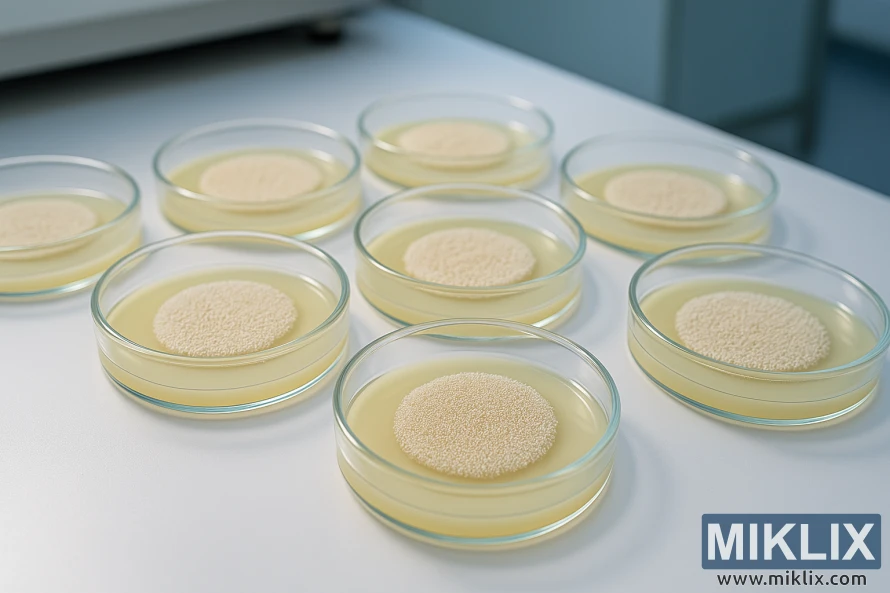Image: Laboratory Petri Dishes Showing Brewer’s Yeast Growth on Agar
Published: November 9, 2025 at 12:14:10 AM UTC
High-resolution image of Petri dishes containing brewer’s yeast strains cultivated on agar, arranged neatly on a sterile white lab bench under bright lighting.
The image captures a meticulously composed, high-resolution photograph of a laboratory scene focused on a series of Petri dishes containing growing brewer’s yeast strains. The setting is a clean, modern lab environment characterized by order, precision, and a sterile aesthetic. The color palette is dominated by whites, silvers, and soft yellows, reinforcing the controlled and hygienic atmosphere typical of microbiological research facilities.
Eight Petri dishes are visible, arranged on a spotless white laboratory bench in a staggered formation that conveys visual balance and scientific organization. Each dish is made of clear glass or high-grade transparent plastic, allowing a detailed view of the agar medium and the yeast colonies developing within. The agar itself has a pale yellow hue, consistent with nutrient-rich growth media such as YPD (Yeast Extract Peptone Dextrose) agar, commonly used for culturing Saccharomyces cerevisiae—the brewer’s yeast species often employed in fermentation studies, biotechnology, and brewing research.
Centered within each dish is a circular colony of yeast exhibiting a creamy, off-white coloration and a distinct texture. The colonies are dense yet finely granular, displaying the characteristic appearance of healthy yeast growth: slightly domed in the center, with uniform edges that suggest even distribution and controlled incubation conditions. The surfaces of the colonies show minute, velvety microstructures that catch the diffused laboratory lighting, revealing the complexity of microbial morphology. Subtle variations in colony size and density among the dishes may indicate different growth stages or experimental variables, such as strain differences, nutrient composition, or incubation duration.
The laboratory lighting is bright and evenly distributed, likely emanating from overhead LED panels designed to minimize glare and shadow. This uniform illumination ensures accurate visual observation of cultures and emphasizes the sterile quality of the environment. The soft reflections on the Petri dish lids and the polished lab surface contribute to the clinical precision and high fidelity of the scene.
In the background, faint outlines of laboratory equipment and cabinetry can be discerned, rendered in cool tones of blue-gray that fade into a gentle blur. This shallow depth of field isolates the Petri dishes as the focal subject, directing the viewer’s attention to the yeast colonies while still providing environmental context. The composition’s low viewing angle gives a sense of perspective, allowing appreciation of both the horizontal arrangement of dishes and the delicate curvature of the transparent lids.
Every element in the image underscores scientific rigor. The alignment of the dishes is intentional and exact, reflecting standard laboratory practice where sample organization ensures accurate labeling, reproducibility, and ease of analysis. The sterile bench surface, devoid of clutter or instruments, highlights a controlled setting suitable for microbiological experimentation, possibly in the context of brewing science, fermentation research, or genetic studies involving yeast as a model organism.
The photograph captures not only the visual aspects of yeast culture but also the underlying narrative of modern laboratory methodology. The clarity and detail evoke the precision and discipline of microbiological work—careful preparation, aseptic technique, and adherence to experimental protocol. At a symbolic level, the image conveys the dual nature of brewer’s yeast as both a cornerstone of traditional fermentation and a modern biotechnological tool used in everything from beer production to synthetic biology.
From a technical perspective, the image demonstrates expert photographic control over lighting, depth of field, and material representation. The textures of agar and yeast are rendered with realistic tactile quality, the transparent glass dishes show accurate optical refraction, and the interplay of matte and reflective surfaces communicates authenticity. This realism is complemented by the soft color grading, which maintains the natural warmth of biological material within a sterile environment.
Overall, the image represents an idealized yet realistic portrayal of a brewer’s yeast study environment—a perfect intersection of microbiology, craftsmanship, and scientific aesthetics. It could serve as an educational or illustrative asset for topics related to fermentation science, biotechnology, microbiological research methods, or laboratory design. The controlled harmony of light, texture, and composition encapsulates the quiet precision and beauty inherent in scientific exploration.
The image is related to: Fermenting Beer with Bulldog B49 Bavarian Wheat Yeast

